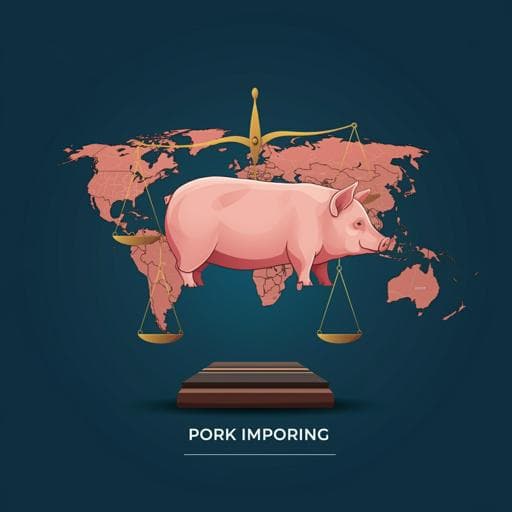
Economics
Potential factors in determining cross-border price spillovers in the pork sector: Evidence from net pork-importing countries
J. Guo and T. Tanaka
This study by Jin Guo and Tetsuji Tanaka delves into the intricate dynamics between international and local pork prices across ten net pork-importing countries over a span of 17 years. Discover how factors like self-sufficiency and trade volume play crucial roles in price stability and market efficiency.
~3 min • Beginner • English
Introduction
The study examines how shocks in international pork markets transmit to domestic pork prices in net pork-importing countries and whether self-sufficiency policies can insulate domestic markets from foreign price volatility. Pork is a key protein source and critical to food security; recent shocks such as African swine fever caused substantial disruptions, notably in China and later Germany, affecting global and domestic prices. While many discussions of food autarky exist, few quantify its effectiveness. There is also a gap in understanding determinants of cross-border price transmission, particularly the role of self-sufficiency and trade exposure. The paper investigates causal relationships and dynamic conditional correlations between global and local pork prices and tests how self-sufficiency, trade volume, and substitution via beef consumption affect international-to-domestic price volatility pass-through.
Literature Review
Prior work on food self-sufficiency often uses qualitative approaches; quantitative analyses include stochastic CGE studies and econometric GARCH-DCC applications mostly for cereals and beef. Evidence generally suggests higher self-sufficiency can insulate domestic markets from foreign shocks, though autarky may increase domestic instability if domestic supply is more volatile. Studies on price transmission have largely focused on domestic chains; fewer investigate international links. Guo and Tanaka (2020b) quantified meat autarky for beef, finding higher self-sufficiency weakens global-to-local spillovers. No prior study has quantified the effectiveness of self-sufficiency in swine meat for international price transmission, leaving a gap addressed by this paper.
Methodology
Data: Monthly pork prices for January 2001–December 2018 for international pork price (IPP) and 10 net pork-importing countries: China (CHN), Colombia (COL), Japan (JPN), Mexico (MEX), New Zealand (NZL), Peru (PER), the Philippines (PHL), Romania (ROU), South Korea (KOR), and the United Kingdom (UK). Local price sources include national statistical agencies and FAO GIEWS; exchange rates from FRED (PER and ROU from CEIC). Prices converted to USD. Seasonal adjustment applied using X-13-ARIMA. Returns defined as first differences of log prices. Yearly panel variables (2001–2017) from FAOSTAT: pork production, consumption, export, import, and beef consumption. Self-sufficiency rate (SSR) = (production − export + import)/consumption. Trade volume rate (TVR) = (export + import)/consumption.
Preliminary tests: Stationarity verified with ADF and KPSS (returns stationary; levels non-stationary). Ljung-Box Q² and LM-ARCH tests support GARCH modeling; Bai-Perron tests indicate no structural breaks in returns.
Univariate volatility models: For each series, select among GARCH, GJR-GARCH, and EGARCH by Schwarz Information Criterion. Estimate conditional mean and variance: mean equation r_t = μ + ω r_{t−1} + ε_t, with variance per GARCH (θ + αε²_{t−1} + βh_{t−1}), GJR-GARCH (adds asymmetry γI(ε_{t−1}<0)ε²_{t−1}), or EGARCH (log form allowing asymmetry). Obtain standardized residuals for causality tests and multivariate modeling.
Granger causality tests: Use Hong (2001) test exploiting kernel-weighted cross-correlations of standardized residuals to detect causality-in-mean and causality-in-variance between IPP and each local series over short lags (M = 1–5 months). Reject null if test statistic exceeds normal critical values (1.65 at 5%, 2.33 at 1%).
Time-varying correlations and volatility spillovers: Estimate bivariate DCC-MGARCH models for each IPP–local pair. Conditional covariance H_t = D_t R_t D_t, with D_t holding conditional standard deviations; dynamic correlation R_t derived from Q_t processes. Consider standard DCC (Engle 2002), asymmetric DCC (A-DCC), generalized DCC (G-DCC), and asymmetric generalized DCC (AG-DCC); choose by SIC. Parameters estimated via Gaussian QMLE with BFGS.
Panel models: Convert monthly DCC to annual by averaging monthly values. Estimate two panel regressions across countries (2001–2017): (1) DCC_it = ω_i + δ1 SSR_it + δ2 BEEF_it + ε_it; (2) DCC_it = η_i + θ1 TVR_it + θ2 BEEF_it + ν_it. BEEF_it is domestic beef consumption. Conduct pooled OLS, fixed effects, random effects, FGLS (accounts for heteroskedasticity and autocorrelation), and Prais-Winsten with panel-corrected standard errors (PCSE). Pre-tests: Modified Wald (heteroskedasticity), Wooldridge (serial correlation), Pesaran (cross-sectional dependence); Hausman to choose FE vs RE. Robustness checked across estimators. Country-specific random-coefficient regressions (Swamy 1970) further assess heterogeneity.
Key Findings
Univariate GARCH selection and diagnostics: GARCH chosen for IPP, JPN, NZL, PER, PHL, ROU, UK; EGARCH for CHN, COL; GJR-GARCH for KOR, MEX. Significant α and/or β confirm volatility clustering broadly; significant asymmetry γ for CHN, COL, KOR, MEX (leverage effects).
Granger causality-in-mean (Table 6): IPP → CHN significant with 1-month lag; no feedback CHN → IPP. No significant IPP → local mean causality for other countries. Local → IPP mean causality observed for COL, KOR, MEX, PER, PHL, ROU, UK at certain lags (e.g., MEX → IPP strongly significant across M=1–5; UK → IPP significant at M=1–4).
Granger causality-in-variance (Table 7): IPP → CHN and IPP → COL significant; no feedback in variance for these. Bidirectional variance causality between IPP and ROU (significant at some lags). UK → IPP variance causality significant (e.g., across M=1–5), indicating the UK’s domestic market can influence international volatility.
DCC model selection (Table 8): Best models by SIC: DCC for JPN, MEX, ROU; A-DCC for CHN, COL, NZL; G-DCC for KOR, PER, PHL, UK. AG-DCC not selected for any pair.
Time-varying correlations (Figure 2; Table 9): DCCs vary over time and across countries. Correlations often rise during turmoil (2007–2009 food and financial crises), e.g., KOR peaks in late 2007. Some countries show negative average DCCs (CHN mean −0.051; COL mean −0.114; NZL mean −0.047; UK mean −0.025), suggesting delayed or inverse co-movement. Others show positive averages: MEX 0.141; ROU highest mean 0.155. KOR exhibits maximum DCC 0.948; UK minimum −0.630. UK has highest DCC volatility (std 0.157); CHN most stable (std 0.027).
Panel regressions (Table 11): SSR reduces DCC significantly across models: δ1 ranges −0.233 (fixed effects) to −0.119 (FGLS), consistently negative and significant (mostly at 1%). TVR increases DCC: θ1 ranges 0.207 (fixed effects) to 0.133 (PCSE), all significant. Beef consumption (BEEF) reduces DCC in most models (negative and significant; fixed effects occasionally insignificant), indicating substitution dampens international spillovers. Wald tests significant across models; R² modest (e.g., 0.177 for SSR model pooled OLS; 0.193 for TVR model pooled OLS). Observations: 170.
Country-specific random-coefficient results (Table 12): Generally SSR and BEEF negative, TVR positive, consistent with panel results. Exceptions include CHN (SSR positive, TVR negative, BEEF positive) and UK (coefficients with opposite or insignificant signs), aligning with unique causality patterns (rapid CHN response to global shocks; UK leading role affecting IPP).
Overall: High self-sufficiency and low trade exposure mitigate global-to-local pork price volatility spillovers; greater trade exposure strengthens transmission; substitution toward beef consumption weakens spillovers.
Discussion
Findings indicate that increasing self-sufficiency mitigates international price volatility transmission to domestic pork markets, but policy interpretation requires caution. Autarky can destabilize prices if domestic supply volatility exceeds that of imports and domestic production weight is high. Higher trade volume rate strengthens cross-border volatility co-movement; even with high self-sufficiency, substantial simultaneous exports and imports can maintain strong external exposure. Dietary diversification via substitutes like beef can buffer foreign shocks at potentially lower fiscal cost than raising self-sufficiency through tariffs or subsidies. Country heterogeneity matters: China shows rapid transmission from global to domestic markets; the UK exhibits domestic-to-global influence, reflecting differing market integration and roles. Policymakers should balance efficiency gains from open trade against stability benefits from higher self-sufficiency, considering agents’ expected utility and fiscal costs, and may reduce external linkage by increasing autarky while curbing trade volumes.
Conclusion
The study uses GARCH-based Granger causality and DCC-MGARCH to assess international-to-domestic pork price linkages in 10 net importing countries (2001–2018) and quantifies determinants of cross-market co-movement. Key conclusions: (1) Causality patterns vary by country; Romania exhibits bidirectional variance causality; China shows unidirectional IPP → domestic causality; the UK shows domestic → IPP causality. (2) Higher pork self-sufficiency and lower trade volume rates attenuate dynamic correlations between global and local prices, indicating reduced volatility spillovers. (3) Greater beef consumption dampens spillovers, consistent with substitution effects. Compared with cereals, meat markets display more instances of negative or weak average DCCs and stronger co-movement during crises. Future work should convert volatility-spillover reductions into monetary terms using risk aversion measures to evaluate cost-benefit trade-offs of self-sufficiency policies and extend analysis to internal price layers (wholesale/producer) and exporting countries.
Limitations
The analysis excludes internal price layers (e.g., wholesale, producer prices), focusing only on global-to-retail pass-throughs; thus, it may not capture internal transmission dynamics. Results are not directly applicable to net exporting countries, where self-sufficiency exceeds 100% and interacts with higher trade exposure (greater TVR), producing mixed effects. Autarky may increase domestic instability when domestic supply volatility is higher than foreign supply, so self-sufficiency is not universally stabilizing. Yearly SSR/TVR data necessitate aggregation of monthly DCC to annual averages, potentially losing high-frequency variation.
Related Publications
Explore these studies to deepen your understanding of the subject.







